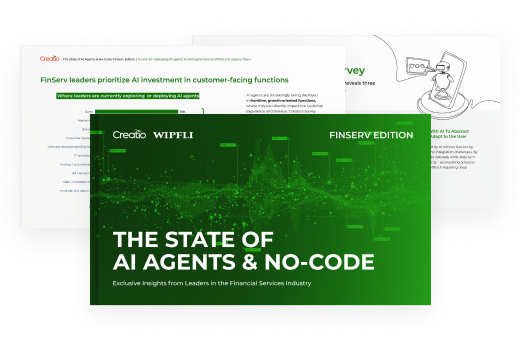-
No-Code
Platform
-
Studio
No-code agentic platform delivering the fastest time-to-value and the highest ROI
-
Studio
-
AI-Native CRM
CRM
-
AI-Native CRM
New era CRM to manage customer & operational workflows
CRM Products -
AI-Native CRM
- Industries
- Customers
- Partners
- About
Creatio: Power Banking Ops With AI & No-Code

The banking industry we have known for years is transforming, and automation holds the key to survival. The rapid growth of digital banking technologies and FinTech companies have changed the industry dynamics, making banking automation necessary rather than a choice.
A decade ago, digital banks were new entrants operating within their niche customer segment. However, customers are becoming increasingly tech-savvy and preferring automated digital banking services over traditional banking.
Recent projections from Statista suggest that the Net Interest Incomes earned by digital banks may hit a staggering US$1.50tn in 2024. Yet, that is just the tip of the iceberg. Over the next five years, from 2023 to 2028, the figure is forecasted to grow at an annual rate of 13.39%.

Several reasons have contributed to the growing popularity of next-gen FinTechs and digital banking. They include (but not limited to):
- 24/7 availability and access, along with core services like fund transfer and loan management.
- Smooth user experience from the self-service portal and mobile apps.
- Highly personalized financial insights and recommendations.
- A straightforward, paperless onboarding process.
- Instant transactions.
It’s safe to say that traditional banks are at a crossroads. To ensure survival, they must adapt to a changing industry. That’s where banking automation enters the picture. Automation and technological adoption can address many challenges the banking industry faces.
Today, we’ll find out how automation can be a lifesaver for banks and the top benefits of banking automation. We’ll also share some key insights to help automate your business process.
The State of AI Agents & No-Code: FinServ Edition
Learn how financial leaders use AI agents and no-code to fuel smarter transformation

Difficulties in the Banking Industry That Automation Will Solve
As technology continues to reshape consumer expectations and redefine the competitive banking and financial landscape, banks face pressures from multiple fronts.
While the lure of digital banking and FinTechs is challenging, the underlying difficulties necessitate traditional banks to reevaluate their operations. A closer look at the key challenges would help us understand them better.
Inability to offer a dynamic range of products
Today's consumers are accustomed to various financial products tailored to their diverse needs. Traditional banks often struggle to introduce new products quickly by operating within their legacy systems. As a result, they may lose potential opportunities for more revenue and retaining more customers.
Lack of personalized customer experience
Digital natives look for experiences that are carefully tailored just for them. Banks, on the other hand, go with a one-size-fits-all approach. Any changes involve many days of manual research, analysis, and cross-departmental collaborations.
Also, launching a new product means providing training to the customer support team, which is resource-intensive.
Procedural delays with everyday operations
In an era where instant gratification is the norm, procedural delays in regular banking and commercial activities such as loan approvals, account set-up, or even fund transfers can frustrate customers, pushing them towards faster alternatives.
Instead of waiting for regular business hours, customers now expect round-the-clock banking availability.
Increased staffing and operational costs
Operating a physical branch is increasingly expensive for many reasons, including rising:
- Real estate costs and rentals
- Utility payments
- Corporate and housing taxes
- Salaries and wages
The hardships and expenses ultimately cause conventional banks to lose their competitive edge.
Failure to leverage data for business success
Banks have various industry and customer data available. However, they are often unsure how to leverage it for business success and use it best because it is usually not processed and organized for analysis. So, banks cannot generate actionable insights for growth.
Low scalability and cost of physical data centers
Many conventional banks still rely on physical data centers for storage. One of the problems with relying on a physical data center is that banks cannot scale up or down quickly if needed.
Several other costs are also associated with it, such as real estate expenses, utilities and power consumptions, software and licensing, insurance, etc.
These can pile up and require a significant ongoing investment, further limiting margins.
Security concerns in a digital world
Nowadays, banks have to maintain a semi-automated system with the legacy manual processes. This exposes them to security risks from both worlds. Data security, combating fraud, and dealing with potential cyber threats are now core tasks.
Sustainability pressures
As global conversations shift towards sustainability and green practices, banks must align their operations and investments with environmentally friendly and sustainable practices.
Staying Human in the Age of AI
Learn how financial institutions leverage AI and no-code to boost efficiency while delivering authentic, personalized customer experiences at scale

Benefits of Banking Automation
The bright side for the banking sector is that automation can solve many of the abovementioned challenges. Let’s look at the key benefits banking automation brings.
Smooth and efficient operations
Traditional banking processes involve many steps that cause procedural delays. Consider loan approval, for example.
Receiving loan applications, validating for eligibility, verifying documents and credit ratings, managing mortgages, and proceeding for final approval—human errors and delays may happen at any stage.
Fortunately, you can automate a lot of these tasks and bring human involvement to a minimum. It will not only solve your operational delays but also reduce operational costs. Accenture reported in 2021 that 43% of banks that relied on automation met their cost-saving expectations.
Superior marketing activities
Banks must revamp their traditional marketing and branding strategies to match the highly competitive and dynamic market. They can leverage automation tools and various data analytics tools for:
- Lead management
- Customer base segmentation
- Customizing marketing campaigns
- Tracking effectiveness in real-time
Automation tools also aid you in understanding and analyzing customer responses and emotions towards specific marketing campaigns, allowing you to find the most impactful promotional channels.
Enhanced customer experience
Customers do not like waiting for business hours to resolve their queries. Fortunately, with automated chatbots, you can solve most problems much faster. This will free up your human agents only for crucial and complicated tasks.
So what about dealing with angry customers? It can also be solved with advanced sentiment analysis features with many modern-day automated chatbots.
Improved fraud detection at lower costs
Financial fraud harms both customers and banks. In 2022 alone, the US banking sector suffered a financial loss of $1.59 billion due to fraud related to payment transfers.
AI-powered banking automation tools can leverage advanced machine learning algorithms to quickly scan through millions of translation patterns in seconds, resulting in stricter financial security.
Agile regulatory compliance
The continuously evolving regulatory landscape is one of the long-standing challenges of operating in the financial and banking industry. Due to the interconnectivity of the global banking system, banks often need to adapt to dynamic regulatory policies quickly.
However, complying with the requirements while operating manually is time-consuming and resource-intensive.
On the other hand, you can quickly integrate new rules within your automated system, and it goes operational within days, if not hours.
Advanced scalability
In today's dynamic financial landscape, banks' ability to scale is crucial. In this effort, automated systems play a pivotal role. They provide the necessary adaptability to quickly respond to shifts in market dynamics, surges in customer demand, and the constant evolution of technology.
Who Uses Banking Automation?
Banks and other financial institutions can deploy automation technologies throughout multiple departments, including (but not limited to):
- Customer service: automated chatbots can be used to handle simple, routine requests, freeing up agents to perform more complex tasks.
- Operations and transactions: processing payments, transferring funds, and approving loans may all be done more quickly and accurately with the use of automation, which also cuts down on errors.
- Loan processing: loan applications, credit history, and financial information can all be evaluated by automated systems to quickly identify risk and eligibility.
- Accounting and finance: banks can automate tasks like data entry, financial reporting, expense management, budgeting, forecasting, and many others to improve efficiency, accuracy, and the ability to make data-driven decisions.
- Risk management and compliance: automation helps banks monitor transactions and activities for compliance with regulations and internal policies, generate reports, and quickly identify issues, improving regulatory adherence and risk management.
- Fraud detection and prevention: banks utilize automation to analyze transaction and payment data in real-time and identify suspicious trends and fraud, thereby allowing for quick response and risk reduction.
Implement Banking Automation with Creatio
Now that you know how automation can bring positive changes to the banking industry, let’s find a solution that is both easy to implement and highly functional. Introducing Creatio, a CRM and no-code platform to automate banking workflows and customer engagement with a maximum degree of freedom.

Creatio's solution for financial institutions offers a robust suite of tools and automation capabilities that cover various aspects of banking workflows, from marketing and sales automation to lending and compliance management. It empowers banks to deliver exceptional customer experiences, streamline processes, and remain agile and compliant in a rapidly evolving financial landscape.
Here’s how Creatio helps:
- Marketing: increase demand generation with multichannel marketing campaigns for diverse marketplaces and regions.
- Sales: manage sales opportunities in accordance with predefined automated workflows that help you to carry out the most effective plan of action for each potential customer.
- Customer experience: improve customer experience by ensuring timely responses to inquiries, efficient issue resolution, and personalized services.
- Lending: streamline loan origination, underwriting, and approval processes thanks to automated digital workflows and consolidated customer 360 data.
- Compliance management: maintain compliance, minimize risks, and meet regulatory obligations thanks to consolidated data management, reporting, and automation tools.
- No-code customization: adapt your system to the specific needs of the bank and regulatory specifications, without involving IT specialists and programmers.
- Scalability: handle increased transaction volumes and user loads efficiently while maintaining high performance and reliability.
Conclusion
While there’s no denying that automation services can address many of the challenges related to the banking industry, implementing automation is often expensive and resource-intensive.
This is where Creatio’s no-code platform can make a difference. You won’t need a sophisticated IT team to maintain this intuitive solution. The flexibility and customizability mean you can easily tailor it to your organizational needs.
Discover how Creatio's automation can revolutionize your banking operations






















































